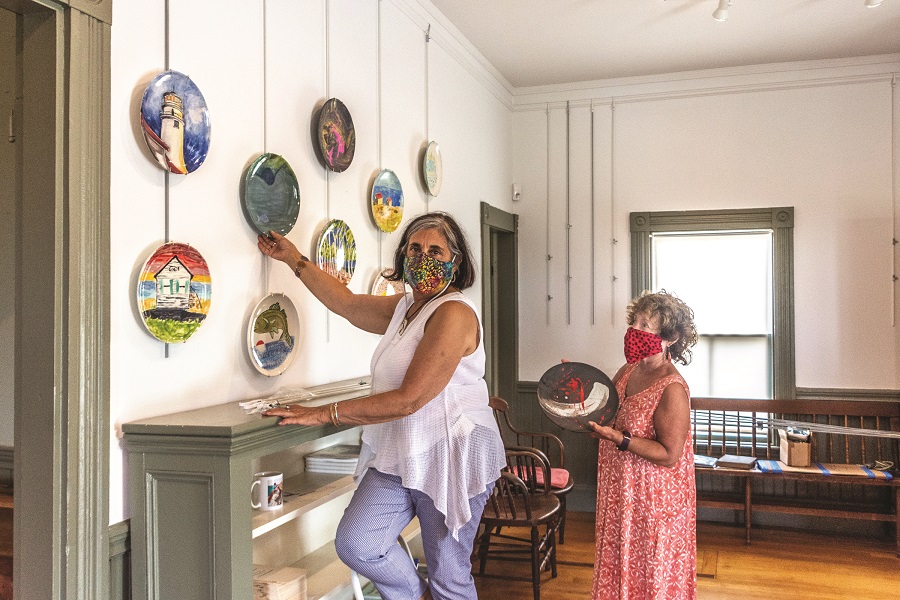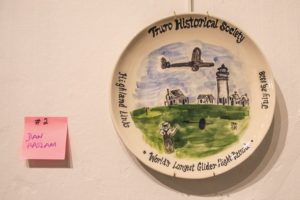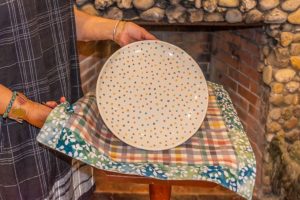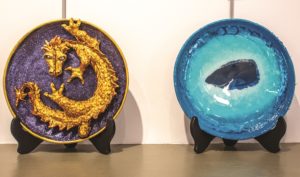TRURO — The wind blew ferociously on June 3, providing a fitting backdrop for the celebration held at the Highland House Museum that day. Annawon Weeden had just put the finishing touches on a wetu — a traditional Wampanoag structure built to withstand Cape Cod’s elements — that he had constructed on the museum grounds.
Highland House Museum
Wampanoag Nation (Fri.)
The Truro Historical Society hosts a free opening reception for its new exhibition “Wampanoag Nation: People of the First Light” at the Highland House Museum, 6 Highland Light Road in Truro, on Friday, Aug. 13, 5 to 7 p.m. See the exhibition and meet the curators, advisers, and contributors. Information at trurohistoricalsociety.org.
Woodland Story (Wed.)
The Truro Historical Society hosts artist and author Deborah Spears Moorehead for “Eastern Woodland Traditional Storytelling” at the Highland House Museum, 6 Highland Light Road in Truro, on Wednesday, Aug. 11, 5 p.m. She will read from her book Finding Balance: The Genealogy of Massasoit’s People and Oral and Written History of the Seaconke Pokanoket Wampanoag Tribal Nation. Details at trurohistoricalsociety.org.
Colonial Misdeeds (Wed.)
The Truro Historical Society hosts “Native Enslavement and Settler Colonialism in Early New England: Origins, Experiences, and Legacies,” a talk by Lin Fisher, professor of history at Brown University, and Paula Peters, an author, activist, and member of the Mashpee Wampanoag tribe. It will take place Wednesday, Aug. 4, 5 p.m. at the Highland House Museum, 6 Highland Light Road in Truro. Register at trurohistoricalsociety.org.
TRURO HISTORICAL SOCIETY
Highland House Serves Up History on a Plate
Designs tell a Truro story from many points of view
TRURO — A new virtual exhibition opening Friday, July 17, at the Highland House Museum celebrates Truro’s history through paintings on a surprising kind of canvas: ceramic plates.
“Looking Back, Looking Forward, Truro 2020 Plate Project,” includes 50 plates, created by 50 people, including artists and amateurs, year-rounders and summer residents.
It is an extraordinary collection of “plate art” –– not all of it traditional, says Susan Kurtzman, who owns Jobi Pottery and also serves on the board of the Truro Historical Society. Pieces arrived glazed, painted with acrylic, decoupaged, sculpted, and even sewn, she says.
The coronavirus crisis just may have made this collection more interesting than it would have been otherwise. Had things gone according to plan, Kurtzman would have offered a one-day plate-painting event open to artists and other community members inside her gallery at Jobi. The virus crushed that plan.
But community interest in the project remained strong, says Kurtzman. Artists and novices alike rallied to participate from afar. She began to hear from “people who had never painted a painting, people who had never worked on ceramics, people who were stuck at home, or isolated, or out of work.”
Making a meaningful contribution to the exhibition and the museum became only part of the story. Then there was the fact that “people wanted to focus on something positive, to have a worthwhile project,” she says.
Participants who did not have their own supplies were able to collect a “kit” (composed of a plate and underglaze) on the curb outside of Jobi. Kurtzman then put together Zoom classes and videos to coach people along.
Despite the distance in geography and in time, the result was a wholly communal experience of resilience and creativity. And then plates began to appear.

10 plates in two zig-zag rows] Top row plates, left to right, by June Hopf, Diane Messinger, Roberta Lema, Robert Henry, and Carol Warshawsky. Bottom row, left to right, Rochelle Borg, Stephanie Packard, Cammie Watson, Joan Rogers, and Elizabeth Lazeren. (photos Nancy Bloom)

Hanging the show at the Highland House, Susan Kurtzman (left) and Susan Howe, president of the board of the historical society.

Dan Haslam’s plate commemorates that great moment in Truro history — July 26, 1928 — when the world’s longest glider flight record was set at Highland Links.

Former Muppeteer and textile artist Ed Christie designed both plate and placemat.

Valerie Falk’s “Let Sleeping Dragons Lie,” next to Kyle Ringquist’s “Underwater Series.”
Bidding on the plates will be online, with the funds going to benefit the programs and exhibits at the Truro Highland House Museum.
LONG ARM OF THE LAW
Wampanoag Tribal Land Is Threatened
Feds tell Mashpee tribe its reservation will be ‘disestablished’
TRURO — A new exhibition is being created at the Highland House Museum. Its purpose is to reframe the celebration of the 400th anniversary of the arrival of European settlers here, taking into account the history of the Wampanoag peoples.
While the Outer Cape awaits its opening, the federal government has taken its own approach to resituating Wampanoag history. In an afternoon phone call on March 27, the Dept. of the Interior informed Mashpee Wampanoag tribal leadership that their 320-acre reservation would be disestablished and taken out of federal trust.
David J. Silverman, a professor of native and colonial American history at George Washington University, told the Independent that the Mashpee Wampanoag have a connection to the Nauset people who inhabited the Outer Cape when the Mayflower arrived in 1620.
People of the First Light, Silverman said, lived in communities throughout the Cape.
“Over time, native people saw their land base diminish,” he said. “They were driven into debt by white creditors and courts, which have a long and terrible history throughout the 18th century, using their power to effectively force people to sell their land and even their children into servitude. Eventually, the only place left was Mashpee.”
State Sen. Julian Cyr of Truro told the Independent that the Interior Dept.’s action was “outrageous and unprecedented.” Because reservations are under the jurisdiction of the federal government, there is little that state legislators can do besides protest.
Still, Cyr is hoping to spur action in the senate through letters to Secretary of the Interior David Bernhardt and U.S. senators Mitch McConnell and Charles Schumer. The letters have over 50 signers, including state Rep. Sarah Peake. “We’re circulating this letter in hopes of conveying our outrage,” Cyr said.
The letter also supports H.R.312, a bill filed by U.S. Rep. Bill Keating that passed the House last year. It would reaffirm the Wampanoag Tribe’s reservation as trust land and require that a suit filed against the tribe be dismissed. But it stalled in the Senate after the president tweeted about it, warning Republican senators not to vote in favor.
Keating told the Independent that the administration’s move was surprising, especially in the midst of a pandemic, when the tribe is focusing on health care. Keating said that lobbyists and advisers to the president have vested interests in preventing the Wampanoag from opening a casino in Taunton. The dissolution is “corrupt,” Keating said. “It’s despicable.”
If the land is taken out of trust, the tribe will not be able to legally operate the casino.
In a March 27 statement, Chair Cedric Cromwell said that the tribe hoped to prevent the loss of their land. “Today’s action was cruel and it was unnecessary,” he wrote.
On March 31, the tribe filed an emergency restraining order in U.S. District Court to prevent the Interior Dept.’s action. They now have 45 days to find a solution. The reservation is the site of health services, a language immersion school for children, and newly constructed homes.
Prof. Silverman said, “Trump himself has a decades-old vendetta against northeast Indians for cutting into his Atlantic earnings with Foxwoods and Mohegan Sun. He called them ‘fake Indians’ who got benefits that they didn’t deserve.”
The Highland House Museum’s exhibition, according to Director Lauren Kaufman, would seek to affirm the native people’s culture. The museum’s goal is to help visitors find out about the culture that had been here on Cape Cod for 12,000 years when the Mayflower landed.
“We hope to send the message,” Kaufman said, “that these people had established a successful life here long before the Pilgrims arrived.”
In Plymouth, George Garmany, governor general of the General Society of Mayflower Descendants, went further in an April 3 statement. “It is no exaggeration to state that the Pilgrims simply would never have survived without the help they received from those Wampanoag people,” the statement read. “All Americans, not just the millions who are descended from the Pilgrims, owe the Wampanoag people a debt of gratitude.”
The statement went on to request that the Interior Dept. reverse its decision.
Having land in trust is important for First Peoples to manage resources, police their community, and live in a way “that’s consistent with their values and interests,” Silverman said. “They have a right to govern their land and people.”
Cyr emphasized that acknowledging First Peoples’ sovereignty and history is a crucial part of their ongoing struggle.
“We’re part of a problematic history, and we’re not only descendants of that history, but our government is continuing to participate in it,” Cyr said.
In his statement, Cromwell wrote of the Wampanoag people’s resilience: “We have survived, we will continue to survive. These are our lands, these are the lands of our ancestors, and these will be the lands of our grandchildren…. We will not rest until we are treated equally with other federally recognized tribes and the status of our reservation is confirmed.”
